If Vaanijyam is most linked with Vaisyas, then Aavesana is most linked with Sudras. The Sudra was not always servant or labourer, but was also an artisan who was master of his craft. He supplied society with deep practical skills of marshaling resources, powering industry, and shaping beauty. Whether it was weaving or wood-working, designing or embroidering, clay-making or jewel-encrusting, the artisan of ancient India would often set the world standard. From textiles and tools to ornaments and objets, the aavesanin was the engine of society who made civilised life possible even for the most ascetic.
Our next article is on Classical Indic Artisanry, more properly known as Aavesana.
Introduction
“There can be no doubt but that culture has been the primary force determining the path of our species has followed in its general evolution.” [3, 2]
The Art of the Artisan is one that finds its way into every facet of civilised life. Silpa Saastra is famed as the art of sculpture, but in fact, encompasses the Fine Arts as an whole. A Silpin was an highly skilled artist, and usually a sculptor, but a regular sculptor in particular was a roopakaara (form-maker) and a painter was chitrakaara. The Arts & Crafts in general were called Kalaa, and encompassed a much larger list including kumbhakaara (potter), thanthuvaaya (weaver), thakshaka (carpenter), ayaskaara (ironsmith), svarnakaara (goldsmith), and maalakaara (garland-maker). Weavers themselves came in many types and included embroiderers and even blanket makers. Specialisation was so pervasive, and skilled labour so plentiful, that availability of material itself would determine availability of finished products.
“Cotton garments from Madurai, Aparanta, Kalinga, Kasi, Vanga, Vatsa; Kauseya (silk) from China bhumi, Dakshinapatha, and Tamralipti; woollen garments from Nepal, Kasmir and Punjab; Linen fabrics from Kasi, Pundra, Magadha and other places; preparation of skin and fur clothes in the north-west of the Himalayas as well as in the western India found frequent mention in various sou-ces” [3,ix]
For all the talk of “perfect competition”, “free enterprise”, and the “miracle of capitalism”, the multi-national corporation known as the East India Company felt such an inferiority complex before Indian artisans, that they infamously began chopping off the thumbs of artisans so as to destroy the native industry of India. Inferior British goods and clumsy cloth from Lancashire could then be dumped on the constrained and cowed (pun intended) populace. For all the politicking peshwas out there, this is the cost of alliance and subsidiary alliance with videshis.
Nevertheless, post-Independence, a chance had reopened for native artisans to re-establish themselves under the auspices of the republican state. It remains to be seen whether elites, landed gentry, or at least upwardly mobile middle classes will take it upon themselves to give patronage to peerless and once-prosperous peasant artists of Bharat.
In #handloom sector #Odisha holds a very unique place for it's designs, techniques, quality and use of colors. #utkaladibasa #ikat pic.twitter.com/bIQk5L9T86
— Sheetal Mishra 🌼 (@itssitu) April 1, 2017
The Handloom industry today stands as bellwether to the state of handicrafts in India. Indeed, while it is critical to revive our Saastriya tradition, it is also crucial to restore our (jaanapaadheeya) folk heritage as well.
“India with her rich cultural heritage is well known for her deep-rooted folk traditions. The Indian embroidery is an embellishment of any material shaped and designed by a needle and thread.” [3, 61]
Terminology
- Aavesana—Artisanry
- Aavesanin—Artisan
- Sudra—Artisan/Peasant/Labourer/Servant
- Prathama Kulika—Chief Artisan
- Nagara Sresthin—Guild President
- Udhyoga—Job
- Udhyama—Industry
- Vyaayaama—Industry/Activity
- Parikryana—Employment
- Parikrtha—Employee
- Paakakushalaha—Skilled in cooking
- Kalaanipunaa—Skilled in art
- Soochi—Needle
- Sauchika—Tailor
- Vaiyithri—Lady weaver
- Thanthuvaaya—Weaver
- Rangakaara—Dyer
- Kambalakaara—Blanket maker
- Pesakaara/Pesakaari—Embroiderer
- Pesa—Embroidered garment
- Urna—Wool
- Sana—Hemp
- Ajinavaasin—Leather garment
- Valka—Tree fibres/Bark
- Thanthi—String
- Vastram—Cloth
- Dhukoola—Best Silk
- Kauseya—Silk
- Ksaumam—Linen
- Karpaasa—Cotton
- Karpatah—Piece of cloth/swatch
- Othu—Weft/Woof
- Veman—Loom
- Thasara—Shuttle
- Thantha cha Praavani—Loom & Shuttle
- Pareti—Spool/Weft
- Tharki—Spindle
- Januh—Product
- Silpin/Rupakaara—Sculptor
- Chitrakaara—Painter
- Kumbhakaara—Potter
- Maalakaara—Garland Maker
- Sankhakaara—Conch Maker
- Svarnakaara—Goldsmith
- Charmakaara—Leatherworker/Shoe-maker
- Karmakaara—Workers
- Ayaskaara/Lohakaara/Dhimaakaara—Blacksmith/Ironsmith
- Ayaskarni—Iron Pot
- Ayaskushaa—Horse Bit
- Abhisu—Horse Reins
- Palyaana—Horse Saddle
- Krshivala—Agricultural labour
- Vaitaanika—Day wager
- Bhaara Vaahaka—Porter
- Yantra Shaala—Factory
- Sthaapathi—Architect
- Thakshaka—Carpenter
- Svadhithi—Chisel
- Mudhgara—Hammer
- Phalaka—Wood
- Lekhaneem—Pen
- Patala/Peetika/Saarani—Table
- Aasandhi—Chair
- Pallanka—Divan
- Nisadhya—Sofa
- Katam—Mat
- Thoolika—Mattress
- Kilimika—Carpet
- Bhisi—Bolsters
Classical Indic Artisanry
https://twitter.com/Tourism_AP/status/1150656486030241792?ref_src=twsrc%5Etfw%7Ctwcamp%5Etweetembed%7Ctwterm%5E1150656486030241792&ref_url=http%3A%2F%2Findicportal.org%2Fwp-admin%2Fpost.php%3Fpost%3D3433%26action%3Dedit
There has been some misunderstanding—much of it purposeful—of the role and rights of Sudras in society. Sudras were primarily freemen workers & servants, but also Artisans. They practiced handicrafts (Kaarukarma) and graceful arts (Chaarukarma) as well. Thus, they were sculptors, iron-workers, goldsmiths, dramatists, dancers, singers, actors, etc, etc. They had their own guilds (sreni). These eventually entered into trade as well. This is confirmed in the Nitisara of Kamandaki:
“The duty of the Sudra is to render service to the twice-born castes (dvijaanaam) according to the order of priority (the Braahmana, Kshatriya and Vaisya). Arts and crafts (kaarukarma) and fine arts, (caarana or caaru-karma, minstrelsy, dance, dramas etc.) are also considered pure (accepted by the Saastras) occupations for them.”sl.21, s.2. Nitisara [6, 43]
The term sudra refers to a class of occupations that historically aligned with a particular guna. People born in these communities would dedicate their lives to the perfection of their occupation or art—which was usually hereditary, but often based on talent. Though some were more peasant or labourer occupations (i.e. construction worker, fisherman, boatman, maid), many were artisan occupations (sculptor, goldsmith, artist, weaver, etc) and many more were in between. Regardless, these non-dvija communities were a critical part of ancient India.
As Pandit Chelam wrote, all four varnas (including sudra), were considered ‘Arya’, and ‘Dravida” was merely a tribe of ‘Arya’. In any event, regardless of which historical paradigm is subscribed to, it is clear Bhaarathavarsha had risen to himalayan heights in silpa and kalaa alike.
“India has been known as a land of Crafts and Craftsmen. An ancient chronicler of centuries gone by writes: ‘One finds long established industries of the Indian peninsula asserting their excellence in a manner at once characteristic and extraordinary. The same skill is seen in metals, in ivory carving, pottery, mosaics, shawls, muslins, carpets, an excellence attained by these ingenious communities ages and ages ago and still practising them.” [1, 1]
Due to the diversity of nomenclature, Aavesana is the ideal unifying term for Artisanry.
As aavesanin also refers to artisan, aavesana was selected to account for a broad spectrum of professions (contained in it are kaarukarma (craftsmanship) and chaarukarma (music & dance performers)). Aavesana has many meanings according to the Sanskrit Sabdakosha, the most relevant of which are workshop and manufactory. One who owns a workshop is an aavesanin.
Wood, Ivory, Metal, Stone, Leather, Cloth, all were common materials for handicrafts in Ancient India. Indic artisans were, and are, passionately driven by the work itself. “Out of their finely chiselled work comes a breath of greater vitality, rhythm and fluidity as though some sort of a symphony had emerged between the genius of the craftsman, the stone and the creation.” [1, 44]
Philosophy

The patron deity of the Indic Fine Arts is the Vedic god Tvastr. He is mentioned in the Purusha Sukta of the Rig Veda, and is alternately associated with many deities including Savitr and even Indra. Nevertheless, he is most often considered a form of Vishvakarma, himself the deity of Sthaapatya Veda and Vaasthu Saastra.
“The making of things was therefore a noble act, the object a manifestation of Viswakarma. The tradition thus grew of offering a light and flowers to Viswakarma or a deity with a prayer before starting on any operation by a craftsman, for it was an offering to the deity as a sign that he, the worker-maker, was going to enter into communion with the divine spirit.” [1, 7]
This elemental connection to Purusha, with Tvastr conceived as emerging from the navel of Vishvakarma, delineates the centrality of the Divine to Dharmic art. Rather than mere interaction of matter, it is the concept of Supreme consciousness that pervades and sparks material reality. Art too, therefore, is a result of attempting to realise the divine, rather than simplistic expression of human caprice. Having understood this, one can begin to grasp the aesthetic motivating the artistic Indic.
“Traditional Craftsmanship in our country has meant far more than skill with materials, more than manual dexterity in manipulating tools. It has meant a total operation involving the motions, mind, body and the vibrant rhythm that such a co-ordination generates.” [1, 1]
Furthermore, iconography (pratima-kalaa) require an even more rigorously trained sculptor
The iconographer must be adept in the sastras and endowed with insight and lead a life of perfect brahmacharya and the samyama (control over his senses). Before taking up his sacred task of giving a murta, the manifest form to the amurta, the non-manifest one, of the gods—the presiding deities of the destiny of mankind, he should perform the sacrifice and then start japa in order to purify himself of all the secular impurities, so that his hands may be in complete union with the spirit and the mind. A code, indeed of religious discipline, is prescribed. [2, 83]
History

“This is one of the exciting facts about the continuity of Indian craft tradition. It cannot really be dated. It seems to be for all time, for it has in it the germ of truth which man is eternally seeking. It thus symbolises man’s first craftmanship.” [1, 22]
The history of India’s crafts remains almost as occluded as India’s history. While colonial paradigms look for disunity and syncretism, the Indic paradigm asserts unity and originality. While there were undoubtedly new ideas, materials, and techniques introduced over time, there nevertheless was a native tradition that was fundamentally unique and holistic in its approach—regardless of era.
“One of the Harappan sites yielded silk thread. Ancient Egyptians imported fine Indian muslins for their dead. Herodotus was all praise for the Indian muslins. The Rig Veda carries substantial details on the fabrics of that period. In the Yajurveda and the Atharva Veda, garments are described.” [1, 49]
This is is seen not only across eras, but even across mediums.
“Whether large or small, the Gupta forms were elegant and trim, clad in dreamy, diaphonous robes clinging to the body, full of vitality and grace. Bronze, a combination of copper and tin seems to have taken over as the dominant raw mat[e]rial for images. Various metals like ashtadhatu, a combination of eight metals, or panchaloha, an amalgam of five metals, were used to signify the cosmic relationship of the image.” [1, 45]
Insofar as the different parts of India, it becomes apparent that there were regional expressions of an integral tradition that could be found on both sides of the Vindhyas.
“In the south, sites such as Amaravati, Nagarjunk[o]nda in Andhra, Akola in Gujarat, and Brahmapuri in Maharashtra have yielded bronze images in the great Gupta quality, emphasizing a uniform concern and zeal for good craftsmanship in metal casting.” [1, 47]
Individual craftsman could rise to tremendous levels of acclaim.
“Where master-craftsmen won wide renown like Kunika, his pupils took equal pride in proclaiming themselves as this master’s pupils for all time, inscribing this fact along with their names on their handiwork, both on the famous Parkham Yaksha and the Yakshini of Mathura” [1, 11-12]
Whether it was the school of Mathura, the school of Gandhara, or the school of Amaravati, there was a consistent thread that could be found across them all, even across traditions.
“Another fact revealed is that often the same set of craftsmen built different style temples, edifices, monuments for different sects, Hindu, Buddhist, and Jain. This confirms that Indian art rises from a single source and is basically an integrated product.” [1, 12]
The Sirpur hoard of the 8th Century CE was demonstrative of this. [5, 6] Clay and stone were not the only media, the master-bronzeman who fashioned numerous statuettes was named here as Dronaditya. Elsewhere, another named Kumaradeva was mentioned. [4,27] Royal artisans were exceedingly valued and were well-respected even by royals.
“Even Panini mentioned the skilled artisans as raja-silpins” [3, 95]. These were in contrast to labourers and day-wagers (vaitaanika), who typically provided unskilled labour. There were also those who provided (visti) or corvee labour. This was not chattel slavery, but work in lieu of pay for a specified time—either to pay debt or taxes. “The Arthasastra also indicates that village artisans worked for the king and that the state supervised this type of service and maintained an account of it, keeping a record of unpaid labour, known as ‘Visti’ appears to have sense in the case of artisans who paid their taxes in this form only.” [3, 103]
Regardless of the era, consistent patterns and motifs are legible in the layers of the historical record.
“India has numerous types of decorative pottery, there the blue pottery of Delhi and of Jaipur, made from quartz, with the typical turquoise….In some the decoration is by etching. The important thing to remember is that the shape is always dictated by the function. Kutch and Saurashtra in Gujarat have all the richness of the local textiles, lacquer ware, bead-work, whose ornamental sense seems wonderfully reflected even through clay. There are also novel items like the magic water pot or karagiri which is filled up from an aperture from the bottom, and when the pot is put back on its base the water stays inside and does not run out.” [1, 27-28]
Elements of Aaveshana
“In the Indian tradition it is said that a craftsman is considered accomplished only when his repertoire of creations covers ten different materials which include earth, wood, stone plaster, metal, ivory, etc. In fact, even the title ‘silpi’ was not applied to a craftsman until he became an expert in his line.” [1, 13]
Family Tradition
“There was equal emphasis on proper education and the right environment for the growing youth. Under hereditary craftsmanship, the young craftsman was brought up and educated in the actual family workshop under the discipleship of his father, uncle, or elder brother whoever happened to be the head of that family…Moreover, youth learnt more than technique, he learnt also the true value of things, metaphysics, aesthetics and in short, culture.” [1, 13]
Indubitably, the family system was the basis of the educating the next generation of craftspeople. Whether father to son or mother to daughter, this was the bedrock of not only studentship, but apprenticeship. Traditional brahmanas might speak on the theoretical aspects of Silpa Saastra, but as with all crafts, the best learning is by doing. This theory was always supplemented by practice. Indeed, this was the mainstay of education in the Arts & Crafts. Instructors were often also master-craftsmen from outside the family, who might take on apprentices to power his mills or workshops.
“The teacher was not to keep any worthwhile knowledge as a trade secret from his pupil. On the contrary the teacher was supposed to spur the pupils on to surpass him and take genuine pride in conceding superiority to the students.” [1, 14]
Nevertheless, this was not an either-or proposition, since“…the inscriptions also show the two systems worked side by side. For there are names of craftsmen showing through their geneology adherance to the hereditary custom over two to three generations. The inscriptions also tell us that the craftsmen had become a mobile and turned into an itinerant community with a central location of activity where a collection of master-craftsmen gathered” [1, 12]
Sreni
“Guilds are generally understood to be the associations of merchants or craftsmen for mutual benefit of their members, having their ends protection, monopoly of the trade or craft, good workmanship and fraternal and religious benefits.” [3, 89]
The guild has been discussed at some length in our article on Vaanijya, nevertheless, there are some aspects that are worth discussing in greater depth. “The head of a Guild was called Parmukha (Chief) or Jettaka (Alderman). He wielded considerable influence, even acted as a Minister to a King of Kosala.” [1, 20] Unless there was a question of Dharma, the King would only intervene where Sreni’s own regulations had been broken. In a sense, the sreni was its own self-regulating community, under the aegis of the state.
“The guild united both the craftsmen’s co-operatives and the in-dividual workmen of a given trade into a single corporate body. It fixed rules of work and wages, and standards and prices for the com-modities in which its members dealt…a guild court could, like a caste council, expel a refractory member”. [6, 216] “It acted as a guardian of their widows and orphans, and as their insurance against sickness.” [6, 216]. “The guild was headed by a chief, usually called the ‘Elder’ (jyesthaka, in Pali jettaka), who was assisted by a small council of senior members.” [7, 216-17]
Not only where they very active in safeguarding mutual interest, they demonstrated their civic-mindedness and charity to causes both religious and general. “All over India are to be found inscriptions recording the donations of guilds to religious causes of all kinds, the most famous being that of the Mandasor silk-weavers” [7, 217]
Often craftsmen could become successful industrialists in their own right. One such name known to the Jain texts is Saddaalaputta. He was a potter who became very wealthy, eventually owning 500 potter workshops and a fleet of boats throughout the Ganga system. [7, 216]
“According to ‘Yajnavalkya’, a person who is well-versed in his duties (Dharmana), who is without any prejudice (suchaya), who has no greed (alabha), he should be entrusted to work on behalf of his guild and all should follow (kartabyam) his orders (vachana).” [3, 91]
Though monopolistic tendencies are often attributed to guilds, there is a distinct difference. In contrast to the modern corporation, where shareholders are distinct from managers and workers, the sreni featured shareholder as manager and worker. While there was a pecking order due to seniority and competence, common prosperity was the common interest, rather than merely that of the elect few.
In fact, rather than single monopolies with horizontal and vertical integration, “Traditionally, the number of guilds is supposed to have been 18 but one can compile total of about ‘thirty’ from various sources available to us. It divides guilds into two types—ordinary guilds and the guilds of technical men or silpayatanas.” [3, 91] They possessed their own insignia, with similar seals found even at Harappa. They governed their own affairs, with state interference only in case of dispute or criminality.
Tools

“In a craft orientated society, a master-craftsman was also a social leader and an important entity in the community, for craftsmanship was also a tribute to the high function of the human being who is endowed with attractive talents and is not just a physical frame.” [1, 14]
Perhaps nothing speaks to talent more than tools. There were many instruments that facilitated the creation of objects or services of beauty. These include the spinning wheel (veman), the pottery wheel (kumbha chakra), the needle (suchika), the hammer (mudgara), the chisel (svadhithi), and so on. Delicate motifs and fine detail was done with pen (lekhaneem).
Weights and measures were certainly valuable, not just for gauging value of product-for-sale, but also for determing the right amount and measuring the right length of material.
Processes
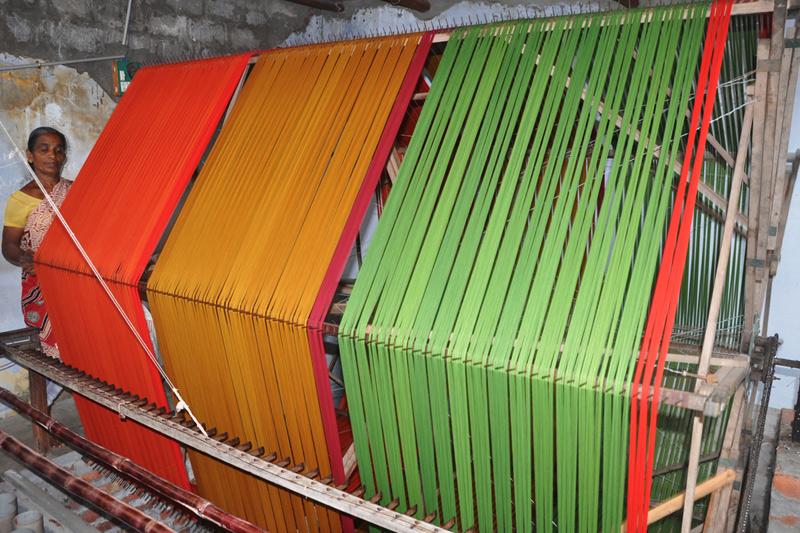
Weaving
Weavers were among the most prominent of the 18 types of guilds mentioned in the Jaatakas. Thanthuvaaya was the word used for weaver in the Ashtaadyaayi. Avaya was the weaver’s workshop which featured his loom. The charkha may have been mythologised in Gandhian India, but the loom & shuttle (Thantha cha Praavani) have a long and ancient history in Bhaarathavarsha. State enterprises—the Public Sector Undertakings of the Mauryan era—are mentioned in the Arthasaastra as providing reservation for widowed women and single mothers needing respectable livelihood. In fact, special provision was often made for well-bred women in need to not even leave home, but to have state employed female agents provide looms and inspect & collect their work. Nevertheless, these PSUs aside, weaving and textiles were otherwise “cottage industries” that were typically “decentralised” and typically private family or guild run endeavours. [3, 101]
Either way, in the department of semi-transparent and diaphanous silks, India has long set the standard in textiles and weaving.
“Perhaps India was the first country in the whole wide world to have perfected the art craft of weaving. It is believed that fine weaving passed on from India to Assyria, Egypt and through the Pho[e]necians into Southern Europe.” [3, 53]
Embroidery
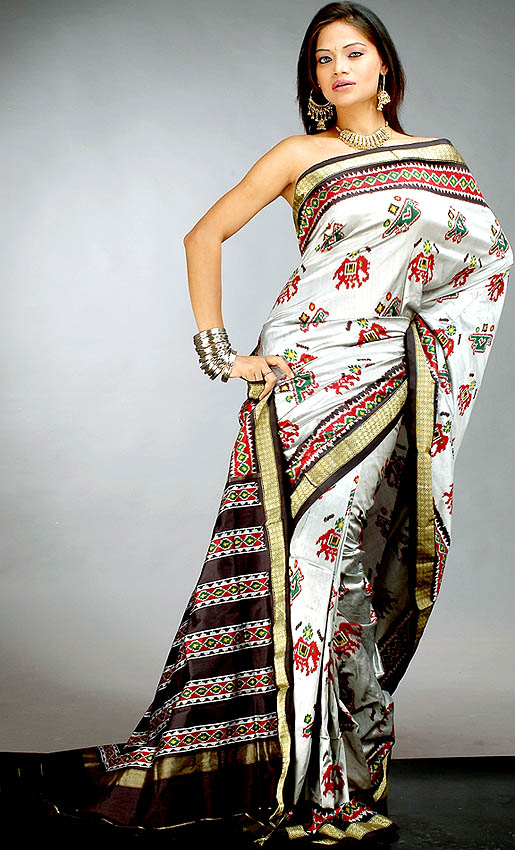
“Embroidery is obviously, a very ancient craft in India for it is referred to in the Vedas and the Indian Epics.”[3, 73]
Pesa refers to an embroided cloth, and a pesakaara/pesakaari was an embroiderer. Due to the delicacy of their skill, ladies were more often than not, the outstanding embroiders of those eras.
Embroidery in particular was considered a valued skill and art: “The atka was a long and fully covering close fitting cloak, bright and beautiful, the stuff being bleached cotton interwoven or embroidered with gold threads while pesas was a gold embroidered cloth, the design being artistic and intricate and inlay of gold heavy and brilliant.” [3, 63]
Cloth could be found in many fabrics and forms. Buddhist and Jain sources mention many varieties: Kanagakanta (cloth having gold tissue borders), Kanagapatta (cloth interwoven with gold tissue), Kanagakachiya (cloth embroidered with gold thread), Kanagaphysiya (cloth with tinsel print gold designs), Javaniya (curtain adorned with precious stones), Patta juyala (diaphonous cloth). The last one is said to have been worn by none other than Mahaveera himself, and was said to have been so light, that the slightest breath would cause them to fly away. The town of Varapattanugaya was said to produce this and many other such textiles in Ancient India. [3, 65]
“Number of garments have been mentioned in Rgveda which confirms our belief. The inner garment was called ‘neebi’. Over it was worn cloth or ‘bases’ and above all was worn ‘adhivaas’ other names of this ‘adhivaas’ are ‘atka’ and…drapi.” [3, 73]
Adhi-vaasa (garment for the upper body), Usneesa (turban), Kambala/Astarna (woolen blanket/shawl), Draapi (mantle or cloak), Vaatha-pana (wind guard), Samoola (kurtha), Pravara (variant of shawl), and pravarana (curtains) [3, 73] Needle were made of iron, bamboo, and horn and typically measured an angula (1 finger length). “In the law-books, we find it repeatedly insisted that men should be dressed properly, while women were usually required to be completely covered.” [3,75]
Dyeing
Garment Dyeing—vastrabhedana—was a famed process in ancient India. The vastrabhedaka often worked on the shop premises (rayagashaala) itself.
“Not decorative motif alone but colour also plays a vital part in Indian textiles. Dyeing of cloth was essential for increasing its beauty. What made the Indian textile fabrics more interesting was the variety of colour employed in dyeing them. So the art of dyeing was in vogue since remote past and it was an important occupation during the period mentioned.” [3, 66]
A number of different colours became associated with India itself perhaps none more so than the eponymous Indigo blue. “Chinese at one time imported indigo from Persia, where it was, doubtless, derived from India. Hence we may assume that India spread it through Persia to China in layer years.” [3, 147] Nevertheless, there were a variety of colours that marked the palette of Bhaarathavarsha, and made their mark through wholly natural resources. Purple dye is one such example and was produced from the madder (majistha) plant. The discovery of one such dyeing vessel at Harappa and Mohenjo-daro indicate the antiquaty of the process in general.
“The love of brilliant colour combinations like vermilion and yellow, is ingrained in the minds of the Indian people…The chief characteristic of the use of colour in Indian textiles is the principle of rhythmic contrasts.” [3, 66]
Various roots, trunks, and barks of trees, as well as leaves, flowers and fruits were utilised to develop a variety of dyes to beautify fabrics and features. The chinkura plant was used for yellow, kumkuma for saffron, collyrium for black, blue lotus for the obvious, and a host of other flowers from sireesa and beyond. [3, 69]
There were applications to beauty-care as well. Rather than the assortment of unhealthy chemical compound based cosmetics, the Bhaarathiya Naari of yesteryear relied on natural colours to accent her beauty. “Even the women of that period had dyed their lips and sometime their feet and nails of the fingers with ‘[a]lakthaka’ (lac dye) but to reduce the vivid redness and to perfume, ‘lodhra’ dust was sprinked over the lips.” [3, 68]
Soda (sajjieeyakhaara) was a common washing agent. Tasar and wool were mentioned in the Maanava dharma saastra as ideal to be cleansed by alkaline earth. Tibetan shawls were to be cleansed with arista, fine silk with the pulp of the ‘bact’ fruit, and linen with the ground paste of white colza seed (svetasarsapa). [3, 70] General painting (i.e. Scroll Painting) was an associated art.
Carving
From religious iconography to toy-making, carving has long been a prize kalaa of India. From the Little Clay Cart (Mrcchakatika) to the modern Etikoppaka cart, Indian toys have long been a fixture in the psyche of the people of India. The unique aspects of the latter form as segue to the next process
Wax Casting
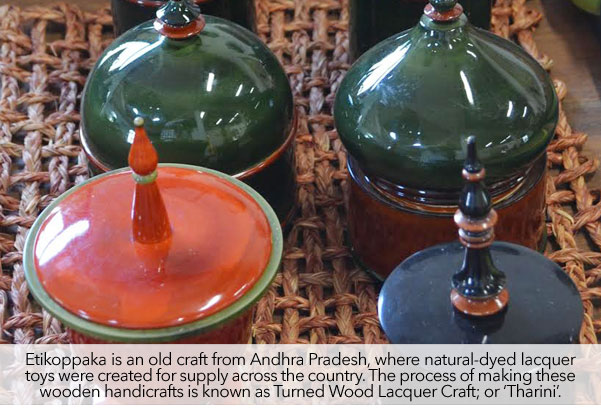
Wax is an important substance (dravya) used in all types of industry and works. From polishing toys to casting metal, wax and wax moulds play a pivotal role in the design of any major vasthu, whether vaasthu based or otherwise.
Materials
Materials used by ancient Bhaarathiya artisans are almost as numerous as days in the year. Here are some prominent ones: Linen, Wool, Cotton, Silk, Leather, Wood, Metal, and Stone.
Linen
“Linen is made from flax, a bast fibre, and is spun into a high quality yarn. Linen is very durable” [3, 30] The material for this fabric was sourced from the Thaarpya tree. In fact, though more commonly known in Sanskrit as Ksauma, it is so identified with this tree that the material itself is often termed as Thaarpya. Linen cloth is called ‘auma‘ in the Ashtaadhyaayi. A related material was hemp (sana), and the hemp plant (dhangaa) was cultivated to be used to sew up wounds and as cloth, per the Sushrutha Samhitha.
Silk
“India was home of arts and crafts from time immemorial and her specialised industries found an appreciative market throughout the globe. Cloth seems to be an important exchangeable com-modity and its industries of many places were famous for its best quality in the remote past.” [3, 118]
Perhaps no textile was celebrated more than the muslins (dukoola) for India. Centres in Gujarat and Bengal, in particular, stood out for their weave and translucence. These semi-transparent diaphanous draperies would achieve fame throughout the world, throughout the ages. Ancient Paundra (a region in Bengal) manufactured black garments which were said to be “as soft as the surface of a gem.” [3, 129] White fabric, that was also soft and akin to the modern muslin, was woven in Vanga proper. Jain texts mention Gauda as a famed centre for silk garments. “Modern Assam has been known in the various periods of Indian history by different name[s]. The Ramayana and Mahabharata call it ‘Pra[g]jyotisa’. In later times it is known by the name of ‘Kamaprupa’. The fame of Assamese textiles has been recorded even in the Harsacharita of Banabhatta (7th Cen. A.D.). The presents sent by king Bhaskarvarman of Assam to Harsa of Kannauj included a variety of fine textiles.” [3, 119]
Perhaps the matter of greatest controversy is in regard to the process of Jari. “Opinions differ regarding the country of origin or the place of discovery of the art of ‘Jari Making’… Though the birth place of this art is not definitely known, evidence available in the ancient literature of India, e.g., Rgveda, Ramayana, Mahabharata etc. goes to show that art of jari making was prevalent in this country since ancient times.” [3, 130]
Cotton
The Sanskrit word for cotton is karpaasa, and by extension, cloth is karpata. As per Kaatyaayana, the yarn was soaked three times in water before weaving began. “Weaving of cloth presupposes that the preliminary processes of ginning, cleaning, pressing, carding and spin-ning were known and undertaken.” [3, 57]
The legendary banarsi sarees find their progenitor in distant antiquity as well. The Varanasi of old also manufactured silk, cloth in general was a Kaasi specialty. “Kasi cloth was famous for its good quality in the remote past. The recovery of spindle whorls and 19 pottery discs with single performation from 800 B.C. to 600 B.C. suggests spinning and weaving and, therefore, by implication the existence of cottage industry in textile. Buddhist literature abounds in references to the cloth of Varanasi or Kasi. The worlds Kasi-Kuttama, Kasiyan kasikavastra, kasikansu et.c undoubtedly refer to the fabric produced in Kasi. ‘Fine Kasi cloth worth ten thousand pieces’, had become proverbial phrases.” [3, 120]
True to the name, Kapaasigraama, a nearby town to the commercial centre of Vidisha, specialised in cotton and cotton fabrics. Vaishaali was a great commercial and industrial entrepot. Ujjain was another key fabric centre specialising in cotton.Elsewhere, other atypical fabrics are mentioned. For example, “Textiles made from fabrics of tree Patrona were made in Magadha.” [3, 125]
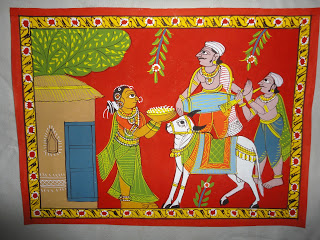
Wool
Sourced from cooler climates, such as Uttarakhand, wool is highly useful for curtains, carpets, coats, and other attire. Use of it, much like silk, is arguably dated to the Harappan Period. Questions remain about whether it was a standalone industry in the Sarasvathi Sindhu. “Probably the wool of Gandhara and of Parushini country and of Sind was highly prized.” [3, 38] Kodambara and Kashmir also featured commonly. Interestingly, “Yaska refers to ‘the Kambojas who are so called because they enjoy blankets [kambala] or beautiful things‘” often made of wool. [3, 122]
Kautilya Arthasaastra is illustrative here with its plethora of plethoras on topics including even types of wool: kambala (wool blanket), kauchapaka (wool woven by cowherds), Kulamitika (head dress), Saumitika (back cover of bullock), Turagaastarna (back cover of horse), Samanta-bhadhraka (back cover of elephant), Vaarnaka (coloured wool blanket), Talichcheka (bed cover), Vaarvaana (wool coat), and Paristoma (large blanket). Distinctions include wool of various colours (vaanchitram), various wool pieces (khandasanghaatyam), and uniform woollen threads (thanthuvichchanam). [3, 40]
In regards to carpets, the South was no slouch in this department.
“Warangal specialized in the manufacture of carpets which were much sought after and other placed had other specialities. Regarding the quality of products of this country. Marcopolo, a traveller of the 13th Cen. says, ‘these are the most delicate buckrums (cotton stuff) and of the highest price; in south they look like the tissue of spider’s web. There can be no king or queen in the world but might be glad to wear them.” [3, 132]
Leather
Though tragically used as a pejorative today in colloquialisms, the ancient charmakaara had a respected role. Though armour was general made of metal, leather armour was also common, as were leather saddles, reins, stirrups, and sandals. Indeed, the great tragedy of the leather-worker’s social position is likely due to the use of non-sanctioned animals for leather. Buffalo leather was and is perfectly acceptable and practicable, and should not have a social stigma. The talents of the leather-worker are not only practical to society, but can often be artistic as well.
Wood

“The same genius that expressed in the giant figures also flowed out into the tiniest toy.” [1, 46]
“Some of the earliest examples of the high quality wood work in houses and temples can still be seen in Kulu, Kangra, Chamba, Kinnaur in Himachal, also in Kashmir.” [1, 35]
Wood was a common material for craftsmanship, not just for houses or decorative panels, but even for toys. In actuality, modern India can benefit from an environmental perspective, by giving patronage again to these non-plastic kreedanikas. Toy-makers throughout India make dolls and other playthings for children. Many are out of wood, some, like the Mrcchakatika, are out of clay.
Clay
“Terracotta blossomed in its artistic vitality in Bengal in the 7th or 8th centuries judging by the rich forms of Mainamati and Paharpur in the Pala era.” [1, 26]
Lepyaja (clay) works form the most humble yet hand-crafted for articles. Mrnamayi, articles made of clay, are among the most basic, and formed the basis for the livelihood of humble kumbhakaara (potter) and industrialist Saddaalaputta alike.
Stone
Stone was the time-tested medium of Silpins for the simple reason that it most easily stands the test of time. Granite, Sandstone, and Soapstone were standard choices. In recent years, marble has become more prevalent.
Metal

Lohaja, or metal-works, were highly prized in every era. This is not only for the artistic reasons, but for eminently practical ones. It was not just weaponery, but highly embellished shields, armours, and helmets can be found to this day. The more royal the patron, the larger the demand for skills and the supply for pay. Paakaja (cast metal) in particular finds value even in modern day handicrafts such as budhithi and pembarthi.
The iron-pillar of Mehrauli is the most celebrated example of Indian metal work. “The metallurgical skill of ancient India is further attested by the fact that this pillar, though it has weathered the torrential rains of over 1,500 monsoons, shows no signs of rusting.” [7, 220].
Jewelers worked hand-in-hand with these experts, to ensure the inlay of precious stones in both jewelry and jewel-encrusted armour alike.
The 64 Arts

“Silpa has also been defined in some texts as synonymous with the Vedic concept of karu, a term which stands for a ‘maker’, covering a wide range of performers, an artisan, a singer, a peon. No difference or distinction was made between the various forms of expression and embraced a wide range of skilled activity from music to horsemanship, painting to cookery, weaving to magic show“. [1, 7]
The Chatussasthi-Kalaa, better known as The 64 Arts, were famed throughout Ancient India as a sign of cultivation. Yet interestingly, many of these arts covered the crafts. Enumerated by Sukracharya in his Sukra Niti, they were subsequently mentioned again in commentaries on the Kaama Sutra. While a few appear superfluous, most are very much practical, and a number are very clearly what we would consider artisanal arts. Sukra states that the Kalaas (arts & crafts) have different names and functions. Here is the full list below. For the purposes of relevance, they have been reorganised from their traditional order.[8, 160]
- Naatya Vidhya—Histrionics
- Narthana/Nrtya Vidhya—Dancing
- Sangeetha Vidhya—Singing & Playing Instruments
- Vaasthu Vidhya—Architecture
- Silpakalaa—Stone Working
- Chitrakalaa—Painting
- Alekhyakalaa—Drawing
- Sayyana Rachana—Laying of beds
- Maala grathana—Garland Making
- Viseshakacchedya Vidhya—Ornamentation
- Kandolakarma—Basket making/Canework
- Mrnamaayi—Pottery
- Thakshana—Carpentry
- Rangakaara—Dyeing
- Pesana—Embroidery
- Thanthavaaya—Weaving
- Prakshaalana—Clothes Washing
- Thanthu Rajju Bandhanam—Thread-spinning & Rope-making/Tying
- Charmakarma—Leather-making
- Soopa Saastra—Cookery
- Madhura Bhakshya—Confectionary
- Paanaka Rasa Yojana—Drink Mixing
- Sasyapaalana—Gardening
- Vrkshaayurveda—Naturopathy
- Dhaathu Vijnaana—Metallurgy
- Akara Vidhya—Mining & Minerology
- Mani Raaga Vidhya—Gemology
- Mani Bhumika Karma—Jewelry Making
- Raupya Ratna Pareeksha—Testing of Metals & Gems
- Rasa Vijnaana—Chemistry
- Kaama Saastra—The Art of Love
- Samvaachya—Conversation & Debate
- Kaavya Kriya—Composition & Recitation of Poetic Verses
- Desa Bhaasha Vidhya—Knowledge of Provincial Languages
- Lipi Lekhana—Writing of Different Scripts. Calligraphy
- Roothavyaaja—Mimicry
- Prahelika—Riddles
- Asthara Mushtika Kathana—Sign Language
- Hastha laghava—Sleight of Hand & Magic tricks
- Aindra Jaala—Jugglery
- Dyootha Kreeda—Dice & Gambling
- Jala Kreeda—Splashing & Swimming
- Kesha Marjana—Hairstyling
- Nepathya Yojana—Dressing
- Bhooshana Yojana—Personal Decoration
- Viseshakaccheda Vidhya—Knowledge of Cosmetics
- Sugandha Yukthi—Perfumery
- Samvaahana—Shaving & Massaging
- Thailakaarya—Oil-pressing
- Laaksha Dhraavaka Karma—Lac. Wax-work.
- Chashaka karma—Glass-making
- Krshaana—Ploughing
- Parvatha Vrksha Rohana—Climbing
- Varsha-Kaala Vidhya—Time-keeping
- Thaamboola Dhaana—Hospitality
- Yantra Maatrika—Mechanics
- Naava Vidhya—Boat Construction
- Prana Bandhana—Wound Healing
- Pattika Vetra Bana Vikalpa—Weapon-making
- Baahu Yuddha—Duelling. Hand-to-Hand Combat
- Vyuha-Vidhya—Battle Arrays
- Ashva Gaja Vidhya—Horse & Elephant Riding
- Pasu Dhamana—Animal Husbandry
- Nirmitthi Jnaana—Portent Interpretation
Much more could be said, of course, regarding the 64 Arts; however, that is best left for a future article. What is ultimately important is that the Arts & Crafts not only delight fellow human beings, but make civilised life possible. The making of the art piece was itself a catharsis and even meditative experience.
“Detachment was parallel with mental peace, for it was not possible to have one without the other. Equally compelling was harmony with the work and the surroundings. It is not surprising therefore that in the craft world yoga, the epitome of discipline, is described as skill in action. In other words it conveyed that as yoga improved the quality of life, so did skill, that the ultimate aim of art was more than savouring an aesthetic experience. It was an enrichment of the total being, ultimately leading to the artist transcending himself for his final liberation. The significance of rasa was transformed into a philosophy to become the highest echelon of the entire hierarchy of knowledge.” [1, 19]
Important Texts
Silpa Saastra
Agni Puraana
Vishnudharmottara Puraana
Yuktikalpataru
Lalitavistara
Chullavagga
Silpa Ratna of Srikumaara
Key Personalities
Vishvakarma
Saddaalaputta
Kunika
Gomitaka
Naaka
Dronaditya
Kumaradeva
Ramappa
Conclusion
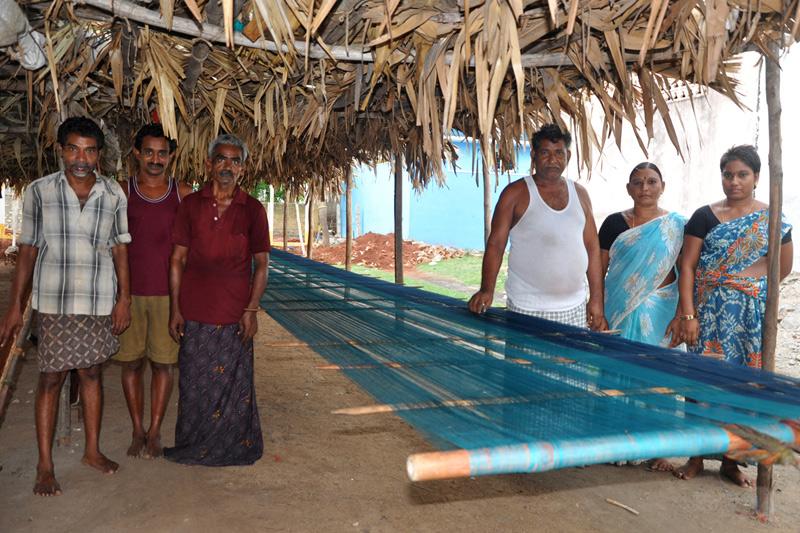
“Organisation was the secret of success of ancient India; it is secret of success of the modern western civilization. Two features characterize the growth of all organisms, physical as well as social: differentiation and integration.” [3, 89]
However, there was and is a key difference between the two systems. If the West has neglected the former, India has forgotten the latter. While the Western Conception of organisation and activity is regimented and top-down, the Indic one remains organic and, and often, though not always, bottom up. If post-modernity in the West can be seen as a response to the assembly-line mechanisation of modernity, then modern Hindu sense of organisation has grown shambolic, self-absorbed, and atomised. Both modern India and the post-modern West can learn from the ancient systems of organisation (whilst rejecting oppressive and unjust aspects).
“Each community lived an integrated pattern of life that responded to the joys and burdens of life, taking them in its flow. There was a natural acceptance of the human cycle like embracing the air and the sunlight, with no resort to escapism. Craftsmanship was thus conceived and nurtured in an embryo of fullness generated by an unhurried rhythm of life.” [1, 2]
It is commonly confused by most semi-literate commentators today that the Bharatheeya Artha Vyavastha (Indic Political Economy) was either “laissez-faire capitalist” or socialist. In reality, it was neither. There was a “policy of ‘mixed national economy’ in which private sector and public sector ran side by side“. [3, 143] Government neither suffocated private enterprised nor socialised private capital’s losses. Dharma guided Artha to ensure praja yogakshema (well-being of the people).
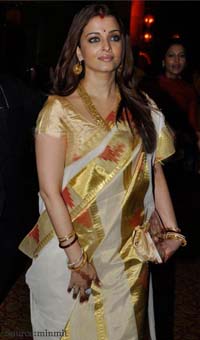
It must be mentioned that Smt. Kiran Singh produced a singularly outstanding book covering many subjects. Though nominally focused on ‘Textiles in Ancient India’, it covers a large number of subjects such as handicrafts, fabrics, industry, commerce, and even inter-civilizational contacts. A number of critical points were asserted by her after in-depth research. For example, it was determined that jari-weave does in fact date back to ancient India.
Furthermore, bodices and blouses were not only the standard in ancient India but virtually universal among all classes (Kerala and forest tribes being the exception due to their idiosyncratic history). While triumphalism and chauvinism should be rejected, so too should mental colonialism and scientism. It is possible to study and appreciate the native origins and native achievement in native arts and crafts, while hewing to the truth. And the truth of the matter is, the bhaarathiya aavesanin was among the world’s best:
“You may watch an Indian craftsman turn his pottery wheel and turn out just these shapes right before ‘your eyes or etch the same birds or animals on a wood panel and the same figure on a slab of stone. We are constantly reminded of this amazing fact that a single unbroken thread seems to have come down through the craftsmens’ hands over several thousand years.” [1, 21]
How abt picking up dese trendy kalamkari products 2day at @OSSSecunderabad ?Support #handloom and ur local weavers 😊 pic.twitter.com/5CklICXrzb
— Sheetal Mishra 🌼 (@itssitu) February 21, 2016
Many may wonder today, in our era of mass-production and 3-D printing, why ancient Indic artisanship should even be studied. But the reality is, with rising unemployment, corporate layoffs, and automation, it is often forgotten where most of the forms of gainful employment once lay: “The handloom in-dustry, especially textile, being the occupation of the largest number of persons in India, next to agriculture“.
“Handicrafts are valuable not merely as a beautiful heritage, but because we need to live with them, touch them, feel them, use them, have intimate communion with them, so that our life is enriched by their grace.” [1]
References:
- Chattopadhyay, Kamaladevi. India’s Craft Tradition. New Delhi: Publications Division. 2000
- Shukla, D.N. Vastu-Sastra (Vol.II): Hindu Canons of Iconography and Painting. New Delhi: Munshiram Manoharlal Publishers. 2003
- Singh, Kiran. Textiles in Ancient India. Varanasi: Vishwavidyalaya Prakashan. 1994
- Quintanilla, Sonya Rhie. History of Early Stone Sculpture at Mathura. Boston: Brill. 2007.p27
- Chandra, Pramod. Prince of Wales Museum Bulletin. Mumbai: ASI. 1957. p.6
- Mitra, Rajendralala & Sisir Kumar Mitra. The Nitisara or The Elements of Polity.Kolkata: The Asiatic Society. 2008
- Basham, A.L. The Wonder that was India. New Delhi: Rupa.1999
- Sukra Niti








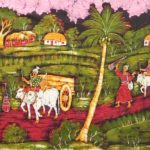
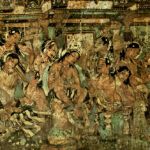
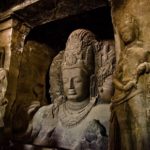
Excellent account of Indic civilization using the category of “avesana” as the lens to explain that its success lay in organization based on physical and social differentiation and integration. More importantly, I liked the author’s assertion that organization of Indic civilization has remained “organic” and often (though not always) from bottom up. In making that assertion, the author has answered the question that Gayatri Spivak raised in her famour essay; “Can the subaltern speak?”‘ Yes, as this article points out, “subalterns” found voice and its articulation (as recorded in the Rigveda onward) through Vishvakarman, Tvashtru and others. This point is elaborated with helpful lists of key personalities, texts, and terminology relating to “subaltern consciousness.” I think , Ribhugana (Ribhu + Vibhu = two sons of Sudhanvan and Vaaj) should be added to the list of key personalities. They were co workers of Twashta (Tvashtru) who specialized in carpentry and arms making (see Rigveda 1:161;1-14; 3:60.1-7). It would also be useful to give references to Vishvakarman (Rigveda 10: 81, 82) and Tvashtru (Rigveda 3:54.12; 6:49.9) etc to make the article more comprehensive.
Thank you for your kind words, Shrinivas ji. Appreciate the suggestions too. Will factor them into a planned future article, referencing your comment, of course. Namaste